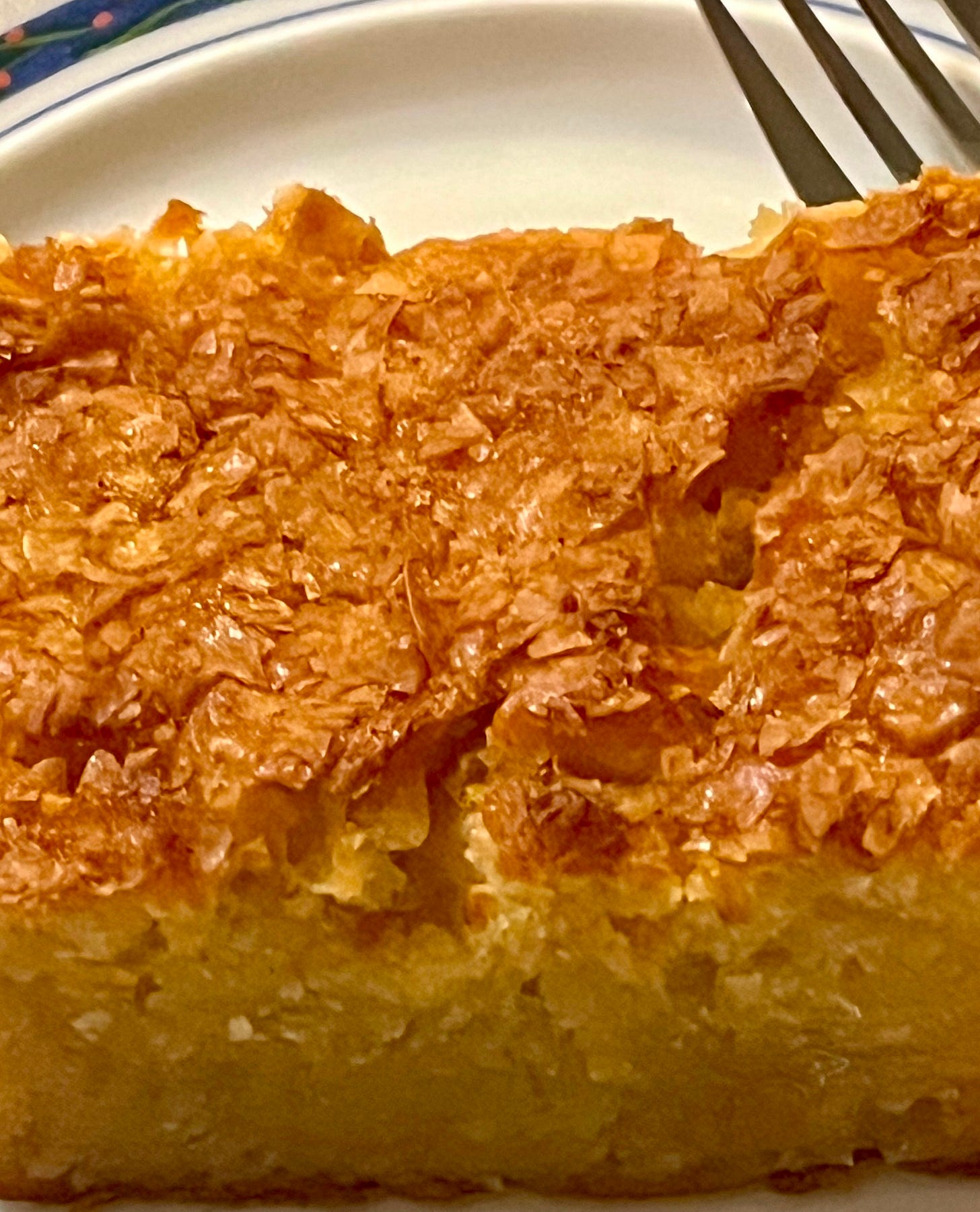First, I want to thank all of my new subscribers for signing up for SweetstreetsNYC. If I’ve missed thanking you individually, I apologize. Life sometimes just gets too hectic. But please know that this food journalist is deeply grateful for your support!
Now, onto Halloween. Or at least SweetstreetsNYC’s version!
First, I have to confess to an addiction. The addiction is to a pie, not an American pie, but a Greek pie, which reads (and tastes) like a cake, a cake redolent of oranges, a cake that’s just sweet enough, a pastry that has me thoroughly hooked.
It’s also a pie, with its orange hue, that would make a perfect Halloween dessert!
It’s called Greek Orange Pie. It looks like a cake, but the name in Greek, portokalopita, means orange pie. Portokali translates into orange, and pita into pie. There is no crust. The only crust-like element is phyllo, which is shredded, then mixed into the batter.
I discovered this sweet Greek delight about a year ago when a branch of Astoria’s Omonia Cafe opened at 2801 Broadway at 108th Street. This compact outpost carries a wide range of traditional pastries like Napoleons and assorted cookies. But the bakeshop also offers a selection of savory and sweet Greek treats—from familiar spinach pie, spanakopita, and the honey and nut pastry, baklava, to less familiar treats like bougatsa (phyllo wrapped around a creamy custard filling).
And there’s also, in the case facing the door, my beloved orange pie.
I love fruit cakes (No! Not the traditional Christmas doorstopper), but strawberry and lemon cakes. So I ordered the orange-hued pastry at Omnia. Then I brought it home, dug in, and immediately fell in love with what I later learned, was in fact, a pie, even though it more closely resembles a sheet cake.
Sometimes I wolf down an entire piece of orange pie (the portions are generous). Other times, in order to savor what’s now my favorite dessert for as long as possible, I’ll cut off a slice, then save the rest in the fridge for later. I’ve made this pie last for an entire week!
Orange pie has been on Omonia’s menu since the family-run outpost opened in 1977, say Culinary Institute of America-trained pastry chef Peter Arvanitis, who has since revamped the cafe’s original recipe. He says the pastry is one of his top-sellers. He learned the current recipe during a stint at a French bakery in Athens, where a friend taught him a traditional method for making the treat.
I asked Arvanitis why the cake, soaked in a sugar syrup, doesn’t taste, well, all that sugary.
That’s because the acidity of the oranges cuts the sweetness, he explains. “The cake itself contains little sugar” and “the sweetness is introduced in the form of a syrup made from orange peels, sugar, and water.”
Arvanitis won’t divulge his orange pie recipe, but he does says that the main ingredients consist of eggs, sugar, oil, fresh oranges and phyllo dough. Then, when the confection is done and removed from the oven, an aromatic syrup made from orange peels, sugar and water is poured over the hot pie.
The entire endeavor “is very time consuming,” Arvanitis says. His bakers always use whole oranges. But peeling, zesting and juicing takes a lot of time. And that’s only the beginning. Bakers then hand mix the dried phyllo with baking powder. Additional steps include ensuring not too much air is whipped into the eggs.
Adds Arvanitis, folding in the phyllo “is a labor of love,” since that process is done entirely by hand.
The substantial investment in hours and labor required to make orange pie caused Paul Fable of Hell’s Kitchen’s Poseidon Baker, a fourth-generation-owned family bakeshop founded in 1923, to stop producing the sweet 13 years ago.
“It took too much time,” Fable says. Among the lengthy processes he employed was the shredding of the phyllo by hand. He could produce only seven trays a day, he says, which amounted to a full day’s labor.
It was all just too much.
“My mom was upset with me,” he says, when he made the decision to stop producing the traditional Greek treat. But in a small bakeshop with only two workers, mixing the pie, which included whisking the batter in an 80 quart pot, then baking it, became “one more thing that took a lot of time,” Fable says.
If you’d like to try your hand at making your own orange pie for Halloween, there are many recipes offered online. And here’s a recipe from Ruby Bhogal of Your Resident Kitchen Klutz.






Looks delicious--I love fruit flavored cakes, too!